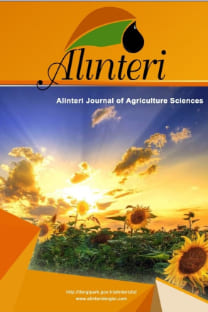İnsan ve Hayvan Beslenmesinde Yeni Bir Bitki: Kinoa (Chenopodium quinoa Willd.)/A New Crop for Human and Animal Nutrition: Quinoa (Chenopodium quinoa Willd.)
Özet: And Dağlarının bitkisi olan kinoa (Chenopodium quinoa Willd.) dünyada insan ve hayvan beslenmesinde geleceğin bitkisi olarak dikkat çekmektedir. Bu bitkinin Güney Amerika'daki tarihçesi çok eskilere dayanır. Arkeolojik çalışmalar bitkinin M.Ö. 3000 yılından beri yetiştirildiğini göstermektedir. Bitki kurağa ve soğuğa dayanıklı olup, yüksek rakımlı dağlık alanlarda tarımı yapılabilmektedir. Ayrıca tohumları mineral, vitamin, yağ ve antioksidanlar yönünden zengindir. Bu makalenin amacı kinoa bitkisinin önemi, kullanımı, besleme değeri ve yetiştiriciliğini tanıtmaktır.Anahtar kelimeler: Kinoa, Chenopodium quinoa , besleme değeri, yetiştiriciliği
Anahtar Kelimeler:
Kinoa, Chenopodium quinoa , besleme değeri, yetiştiriciliği
-
The Andean grain, quinoa (Chenopodium quinoa Willd.) is gaining increasing attention as a future food and forage crop in the world. There is a long history of safe use of the grain in South America. Archaeological studies have shown that quinoa was already known in 3000 B.C. The plant is cold and drought tolerant and it can be cultivated in high altitudes in the mountain areas. Apart from this, its grain is a rich source of a wide range of minerals, vitamins, oil and natural antioxidants. Therefore the objective of the paper is to introduce importance, use, nutritive value and agronomy of the kuinoa.
Keywords:
Quinoa, Chenopodium quinoa , nutritive value, agronomy,
___
- Aguilar, P.C. and Jacopsen, S.E. 2003. Cultivation of quinoa on the peruvian altiplano. Food Reviews International, 19, 31-41.
- Bertero.,H.D. and Ruiz, R.A. 2010. Reproductive partitioning in sea level quinoa (Chenopodium quinoa Willd.) cultivars. Field Crops Research, 118, 94-101.
- Bhargava, A., Shukla, S. and Ohri, D. 2007. Genetic variability and interrelationship among various morphological and quality traits in quinoa (Chenopodium quinoa Willd.). Field Crops Research, 101(1), 104-116.
- Cardozo A. and Tapia M. 1979. Valor nutritivo. In: Tapia M., Gandarillos H., Alandia S., Cardozo A., Mujica A. Quinoa y kaniwa, cultivos Andinos. Bogota CIID, Oficina Rgiond para la america Lotina, pp. 149-192, ISBN: O-88936-200-9.
- Carlsson R, Hanczakowski P and Kaptur T. 1984. The quality of the green fraction of leaf protein concentrate from Chenopodium quinoa willd. Grow at different levels of fertilizer nitrogen. Anim. Feed Sci. Technol., 11, 239-245.
- González, J.A., Gallardo, M., Hilal, M., Rosa, M. and Prado, F.E. 2009. Physiological responses of quinoa (Chenopodium quinoa Willd.) to drought and waterlogging stresses: Dry matter partitioning. Botanical Studies, 50, 35-42.
- Jacobsen, S.E. and Stolen, O. 1993. Quinoa-morphology, phenology and prospects for its production as a new crop in Europe. European J. Agron., 2, 19-29.
- James, L.E.A. 2009. Quinoa (Chenopodium quinoa Willd.) Chapter 1: Composition, Chemistry, Nutritional, and Functional Properties. Advances in Food and Nutrition Research, 58, 1-31.
- Johnson, D.L. 1990. New Grains and Pseudograins. In: Advances in New Crops, Proc. the First National Symp. New Crops: Research, Development, Economics - Indianapolis, IN, October 23-26, 1988, J. Janick and J.E. Simon (eds.), p. 122-127, Timber Press, Portland, Oregon.
- Johnson, D.L. and Croissant, R.L. 1990. Alternate Crop Production and Marketing in Colorado. 1990. Technical Bulletin LTB90-3, Cooperative Extension, Colorado State University.
- Johnson, D.L. and McCamant, J. 1988. Quinoa Research and Development - 1987 Annual Report. Sierra Blanca Associates, 2560 S. Jackson, Denver, CO 80210. Johnson, R. and Aguilera, R. 1980. Processing Varieties of Oilseeds (Lupine and Quinoa), In: Report to Natural Fibers and Foods Commission of Texas, 1978-1980 (Reported by D. Cusack, 1984, The Ecologist 14, 21-31.
- Miranda, M., Vega-Galvez, A., Quispe-Fuentes, I., Rodriguez, M.J. Maureira, H. and Martinez, E.A. 2012. Nutritional Aspects of six quinoa (Chenepodium quinoa willd.) Ecotypes from there geogrophicd areas of Chile. Chilean Journal of Agricultural Research, 72(2), 175-181.
- Prego, I., Maldonado, S., Otegui, M. 1998. Seed structure and localization of reserves in Chenopodium quinoa. Annals of Botany, 82, 481-488.
- Reichert, R.D., Tatarynovich, J.T. and Tyler, R.T. 1986. Abrasive dehulling of quinoa (Chenepodium quinoa): Effect on saponin content as determined by an adapted hemolytic assay. Cereal Chem., 63(6), 471-475.
- Repo-Carrasco-Valencia, R. and Serno, L.A. 2011. Quinoa (Chenepodium quinoa Willd.) as a source of dietary fiber and other functional components. Cienc. Tecnol. Aliment, 31(1), 225-230.
- Risi C.J. and Galwey, N.W. 1989. Chenepodium, granis of the Andes: A crop for temperate latitudes. In; New crops for Food and Industry, G.E. Wickens, N. Hog, and P. Day (eds.), pp. 222-232, Choapman and Hall London and Newyork.
- Robinson, R.G. 1986. Amaranth, quinoa, ragi, tef, and niger tiny seeds of ancient history and modern interest. University of Minnesota Agri. Cultural Experiment Station, Bulletin AD-SB-2949.
- Schulte auf’m Erley, G., Kaul, G., Kruse, M., Aufhammer, W. 2005. Yield and nitrogen utilization efficiency of the pseudocereals amaranth, quinoa and buckwheat under different nitrogen fertilization. European J. Agron., 22, 95-100.
- Sigsgaard, L., Jacobsen, S.E. and Christiansen, J.L. 2008. Quinoa, Chenopodium quinoa, provides a new host for native herbivores in northern Europe: Case studies of the moth, Scrobipalpa atriplicella, and the tortoise beetle, Cassida nebulosa. Journal of Insect Science, 8(49), 1-4.
- Solíz-Guerrero, J.B.,Rodriguez, J.D., Rodríguez-García, R. Angulo-Sánchez, J.L. and Méndez-Padilla, G. 2002. Quinoa saponins: Concentration and composition analysis. p. 110-114. In: J. Janick and A. Whipkey (eds.), Trends in new crops and new uses. ASHS Press, Alexandria, VA.
- Van Schooten H.A. and Pinxterhuis, J.B. 2003. Quinoa as an alternative forage crop in organic dairy farming. Optimal Forage Systems for Animal Production and the Environment Grassland Science in Europe, Vol: 8.
- ISSN: 2564-7814
- Başlangıç: 2007
- Yayıncı: Adem Yavuz SÖNMEZ
Sayıdaki Diğer Makaleler
Göksel TOZLU, Ahmet Semih UZUNDUMLU, Okan GEDİKLİ
B. Tuba BİÇER, Abdurrahim YILMAZ
Harun YILDIZ, Sefa ACARLI, Selçuk BERBER, Pervin VURAL, Fettah GÜNDÜZ
Ekrem MUTLU, Telat YANIK, Tuğba DEMİR
Tüketicilerin Açık Süt Tüketimini Etkileyen Faktörlerin Analizi: Erzurum İli Örneği
Ahmet Semih UZUNDUMLU, Avni BİRİNCİ
Kitinazların Biyolojik Mücadeledeki Etkisi
